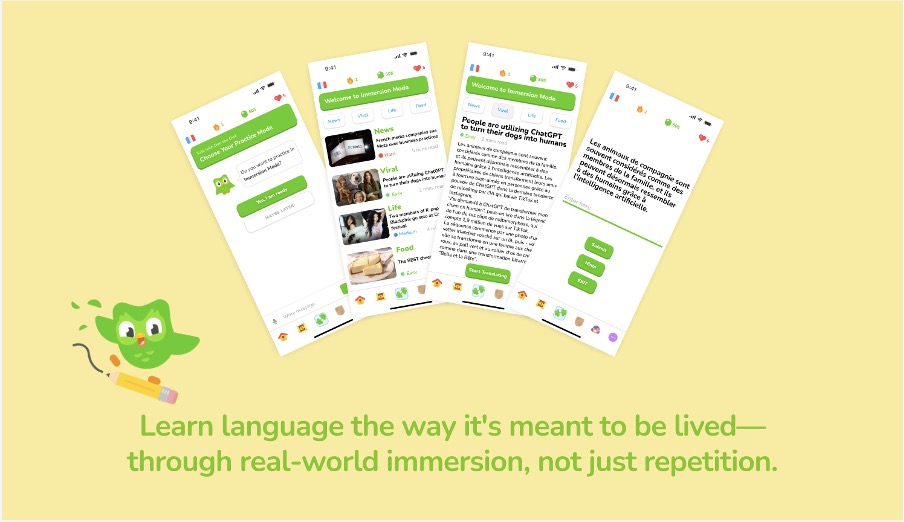
Redesign Duolingo: Immersion Mode Practice
Overview
In this redesign of Duolingo, I proposed a new feature called Immersion Mode—a practice space that brings real-world content directly into the language learning experience. Instead of just gamified drills, users engage with news headlines, viral social media posts, and everyday conversations, learning how to translate naturally-occurring texts with AI-powered feedback. The goal was to create a bridge between Duolingo’s structured lessons and the messy, rich reality of native language use.
Target Users
I designed this feature for intermediate to advanced Duolingo users who’ve mastered the basics but feel unprepared to understand native content in the wild. Through user interviews, I met people like Jane, a grad student learning German who still struggles with Reddit posts, or Carlos, a Spanish learner who travels often but leans on Google Translate. Many of them want to interact with real-world content—tweets, menus, news—but feel unsure about their ability to understand and translate accurately.
Learning Problem
Duolingo is great for beginners, but many users hit what I call a “fluency plateau.” They can breeze through grammar drills and XP levels, but freeze up when trying to read a headline or tweet in their target language. Other tools exist—LingQ, FluentU, Readlang—but they either lack structure, real interaction, or personalized feedback. That’s the learning gap I wanted Immersion Mode to solve: to help users move from safe, structured lessons into more authentic, fluent engagement with everyday language.
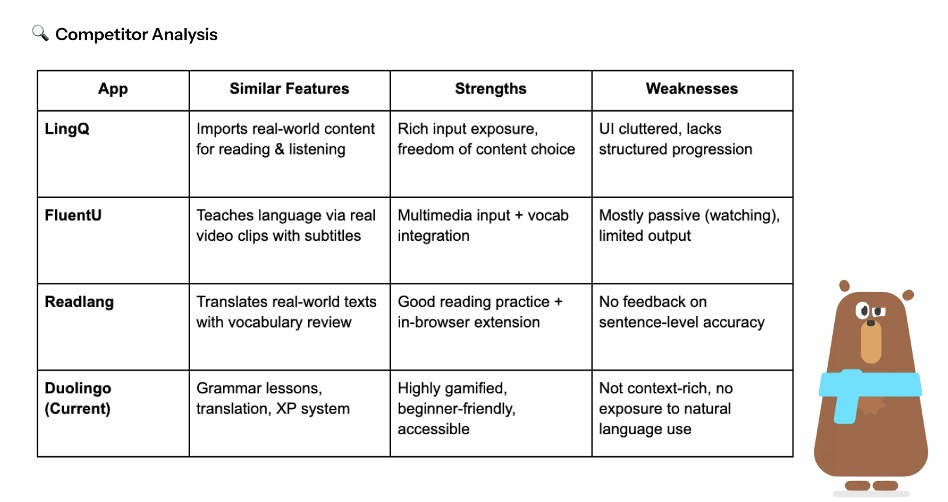
🧩Design Thinking Process
1. Empathize
To ground this project in user needs, I conducted interviews with Duolingo users across different languages and experience levels. I asked them what they struggled with, what content they wanted to read, and how confident they felt using the language in daily life. Nearly all users said they lacked confidence in understanding real-world texts—even after completing multiple units—and they longed for more practical, contextual practice. They wanted help with things like Reddit comments, travel menus, song lyrics, and viral headlines.
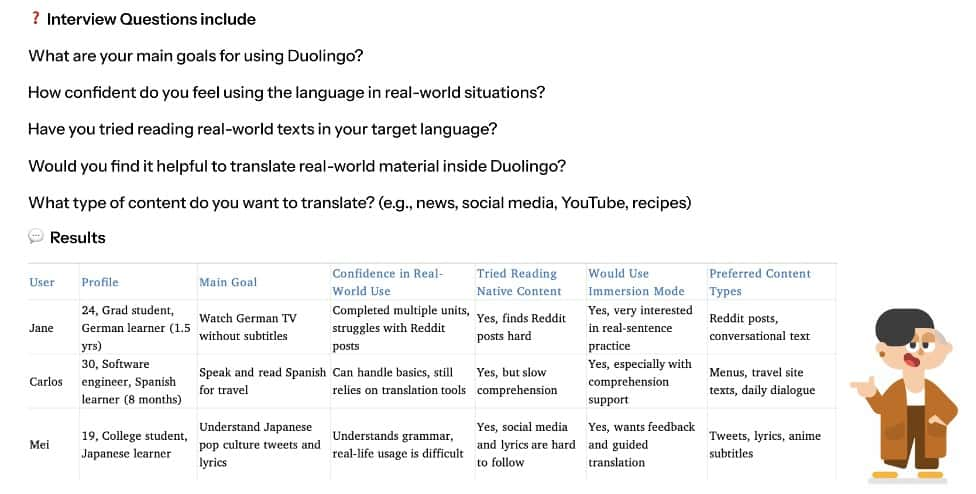
2. Define
From these interviews, I clearly defined the challenge:
“How might we help learners apply their language skills to real-world content in a way that’s approachable, supportive, and motivating?”
It wasn’t enough to just show them native texts—they needed scaffolding, real-time feedback, and the motivation to keep going even when things got tough.
3. Ideate
That’s when Immersion Mode began to take shape. I imagined a feature that lives inside the Duolingo app but opens a new practice path: one that surfaces real-world articles, provides translation challenges, and offers sentence-level support. The idea was to combine personalization (choosing your topic), support (vocabulary hints), and AI feedback (for grammar and syntax accuracy), all wrapped in this new feature.

One day, while browsing online, I stumbled across a quirky headline: “People are utilizing ChatGPT to turn their dogs into humans.” It immediately caught my attention—not just because it was funny and current, but because it was exactly the kind of language learners wanted to understand but rarely practiced with. That moment sparked the realization: why not use real posts like this as content for Immersion Mode? It would make language practice more relatable, timely, and fun!
4. Prototype
I mocked up a full user flow. It starts with a familiar onboarding experience—users choose their language and goals as usual.
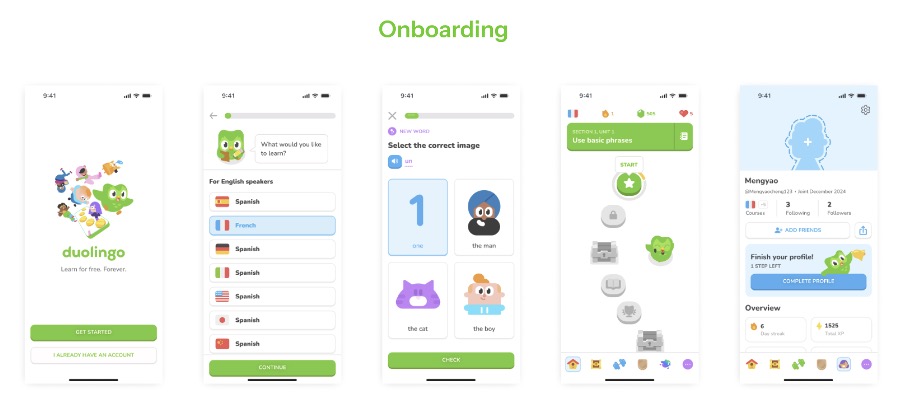
Then, once they reach a certain level, Duo the Owl introduces Immersion Mode through a lighthearted chat. From there, learners select a unit and section (e.g., Unit 1, Section 2 “Daily life vocabulary”), and the app recommends articles in four categories: News, Viral, Life, and Food. Each article preview is shown in English, which helps users decide what they’re interested or comfortable tackling.
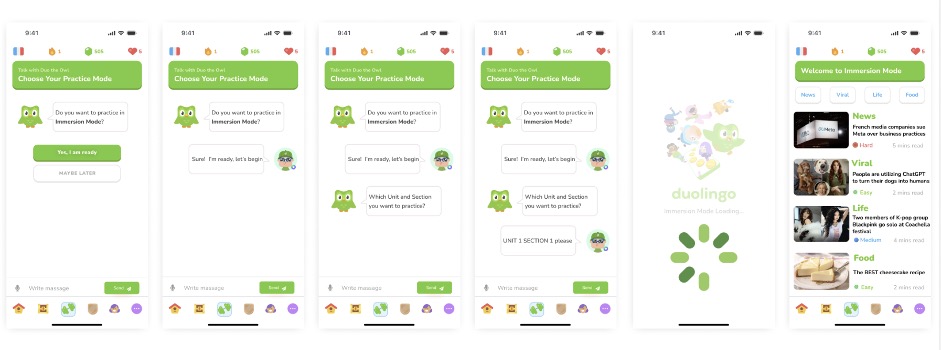
Once inside, they begin translating, sentence by sentence. If they succeed, they get celebratory feedback.
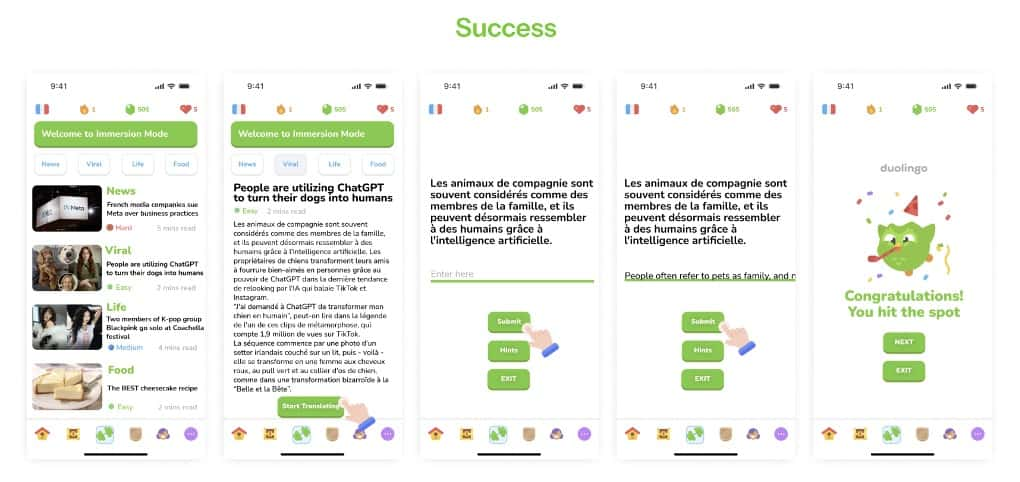
If they struggle, the system points out issues like verb tense or missing context, and offers hints to try again.
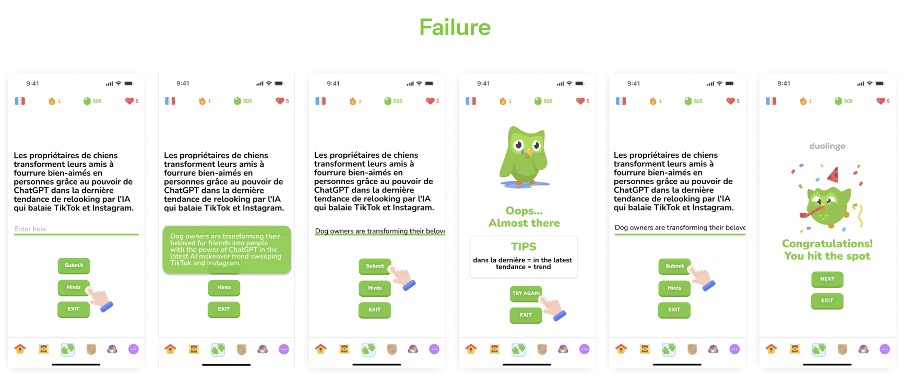
5. Test
This project was my final for the UIUX Bootcamp, and given that it coincided with the end of the semester, I didn’t have the luxury of conducting a full-scale, structured user testing session. However, after presenting Immersion Mode during our final showcase, I took the opportunity to gather quick, informal feedback by talking with a few classmates. I asked them what they thought of the flow, the concept, and whether they could see themselves using a feature like this.
Their responses were encouraging—every one of them said they could clearly understand the user journey and felt that the idea met a real, unmet need in their own learning experiences.
That said, they also offered thoughtful suggestions for improvement. The first was a desire for better summary and reflection tools within Immersion Mode—something that would help them review what new vocabulary they had learned, and whether their mistakes were more about grammar, spelling, or sentence structure. The second was the need for quantifiable, visual performance tracking—for instance, how many articles they’d completed today, their translation accuracy, or how their skill improved over time. These insights made it clear that while the core idea resonated, adding stronger feedback loops and data visibility would make the feature even more impactful.
6. Iterate
Based on the feedback I received during the showcase, I identified two key areas for improvement and made plans to incorporate them into future iterations of Immersion Mode.
First, I want to add a Feedback Summary Report that appears after each session. This report would highlight what the user did well—such as correct use of verb tenses or accurate vocabulary—and where they struggled, such as which parts of the sentence they mistranslated, whether due to grammar, spelling, or word choice. The goal is to help learners not only complete a task, but understand why they succeeded or failed, turning every session into a learning opportunity. Second, I plan to implement a Performance Dashboard to visualize progress over time. It would track metrics like the number of articles completed, translation accuracy, common error categories, and new vocabulary acquired. This way, users could see tangible growth, build learning streaks, and stay motivated through clear, data-driven feedback.
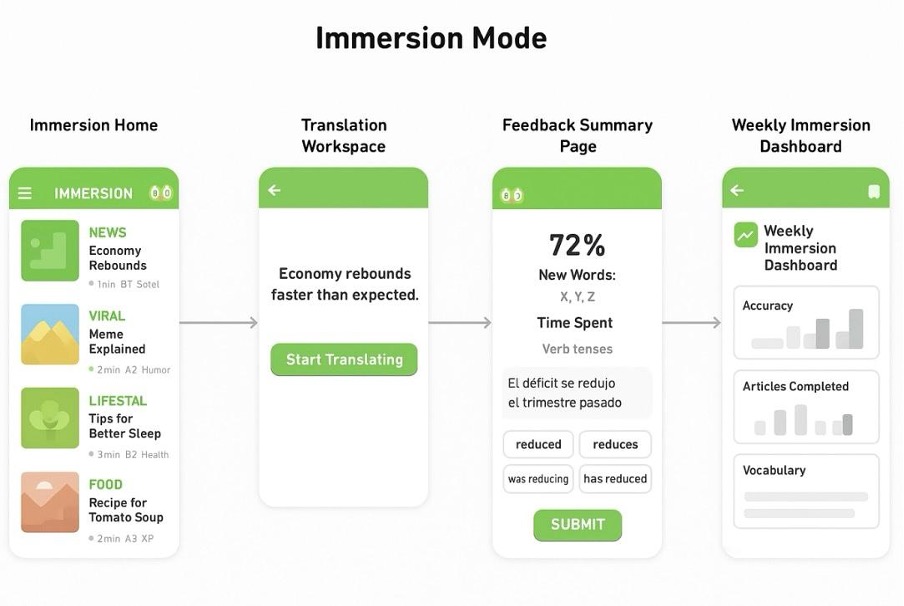
These two additions—reflection and visualization—will deepen the learning experience and make Immersion Mode not just a practice tool, but a smarter, more personalized language companion.